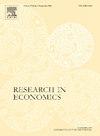自由资本模式下的市场结构与产业区位
IF 1.2
Q3 ECONOMICS
引用次数: 0
摘要
古诺、贝特朗与垄断竞争的比较近年来受到了产业组织学界的关注,但在新经济地理学中却没有得到重视。为了填补这一空白,我们研究了在自由资本模型下市场结构的差异如何影响产业区位。研究发现,国内市场效应在古诺竞争中最强,在贝特兰竞争中次之,在垄断竞争中最弱。并且,我们将产业组织的见解与我们的地理模型联系起来。本文章由计算机程序翻译,如有差异,请以英文原文为准。
Market structure and industry location in a footloose capital model
Comparison among Cournot, Bertrand and monopolistic competition receives recent attention in industrial organization, but not in New Economic Geography. To fulfill this gap, we examine how the difference in market structures affects industry location in a footloose capital model. We find that the home market effect is strongest in Cournot competition, second strongest in Bertrand competition, and weakest in monopolistic competition. And, we link the insights in industrial organization with our model of geography.
求助全文
通过发布文献求助,成功后即可免费获取论文全文。
去求助
来源期刊

Research in Economics
ECONOMICS-
CiteScore
1.40
自引率
0.00%
发文量
37
审稿时长
89 days
期刊介绍:
Established in 1947, Research in Economics is one of the oldest general-interest economics journals in the world and the main one among those based in Italy. The purpose of the journal is to select original theoretical and empirical articles that will have high impact on the debate in the social sciences; since 1947, it has published important research contributions on a wide range of topics. A summary of our editorial policy is this: the editors make a preliminary assessment of whether the results of a paper, if correct, are worth publishing. If so one of the associate editors reviews the paper: from the reviewer we expect to learn if the paper is understandable and coherent and - within reasonable bounds - the results are correct. We believe that long lags in publication and multiple demands for revision simply slow scientific progress. Our goal is to provide you a definitive answer within one month of submission. We give the editors one week to judge the overall contribution and if acceptable send your paper to an associate editor. We expect the associate editor to provide a more detailed evaluation within three weeks so that the editors can make a final decision before the month expires. In the (rare) case of a revision we allow four months and in the case of conditional acceptance we allow two months to submit the final version. In both cases we expect a cover letter explaining how you met the requirements. For conditional acceptance the editors will verify that the requirements were met. In the case of revision the original associate editor will do so. If the revision cannot be at least conditionally accepted it is rejected: there is no second revision.
 求助内容:
求助内容: 应助结果提醒方式:
应助结果提醒方式:


